
Eduard 1/48 Sopwith Camel
| KIT #: | 8055 |
| PRICE: | $32.95 MSRP |
| DECALS: | Four options |
| REVIEWER: | Tom Cleaver |
| NOTES: |

| HISTORY |
The Sopwith Camel is perhaps the most famous World War I fighter plane alongside the Fokker Triplane, primarily due to a thirty-year battle between Snoopy and the Red Baron in the comic strip “Peanuts.” The little fighter is deservedly famous, since it was the most successful Allied fighter of the world’s first air war in terms of enemy aircraft shot down, and the number of pilots who became aces flying it in combat during the last year of the war.
Whereas the Sopwith “Strutter,” “Pup” and “Triplane” - the Camel’s ancestors - each had a reputation as a beautiful flying machine that was easy for a pilot to master, the Camel had a reputation for killing more of its pilots than the enemy did. This was due to a design that grouped a powerful rotary engine, pilot, weapons and gasoline close together in the forward part of the fuselage. While this configuration incurred superb maneuverability, the powerful gyroscopic force created by the spinning rotary engine with most of the weight close to the center of gravity meant the Camel was inherently unstable and could spin easily if not handled carefully. Today’s fighters are built with the same sort of instability, but onboard computers give the pilot an ease of control that would not be possible if he was flying manually the way his Camel-borne predecessors did.
Donald MacLaren - The Top Camel Ace:
 While there were many aces who flew the Camel, most of them - such as
fellow Canadian aces Raymond Collishaw or William Barker - had flown other
aircraft and scored with them earlier in their careers. The top-scoring
Camel pilot of the First World War was a young Canadian who only ever flew
the Camel in combat, making his score of 54 victories in less than a year
on the front an even more impressive feat.
While there were many aces who flew the Camel, most of them - such as
fellow Canadian aces Raymond Collishaw or William Barker - had flown other
aircraft and scored with them earlier in their careers. The top-scoring
Camel pilot of the First World War was a young Canadian who only ever flew
the Camel in combat, making his score of 54 victories in less than a year
on the front an even more impressive feat.
Donald MacLaren was born in Ottawa on May 8, 1893, but spent most of his formative years on the Canadian frontier, as the family moved to the then-small town of Calgary, Alberta, when he was 6. As a youth, MacLaren’s father taught him to shoot, and he put it to good practice hunting game on the Alberta prairie and in the process giving himself an “eye” that would lead to his later. At age 18, he moved with his family to Vancouver. Enrolling as an electrical engineering student at McGill University he had to leave school due to illness after two years. When he was recovered, he, his father, and brother Roy moved to Keg River Prairie, 200 miles north of the closest railroad and went into the fur trading business, where the young Donald MacLaren thrived. He joined a government exploration party which surveyed the 6th Meridian in the summer of 1916. On his return he found his brother had gone to enlist; he did the same in Vancouver, and was accepted into the Royal Flying Corps.
Fortunately, by the fall of 1916, flying training was more comprehensive than it had been in earlier years. Training at Long Branch, just outside Toronto, MacLaren soloed in the Curtiss JN-4 “Canuck” after three and a half hours of dual instruction. After intermediate and advanced flying training and aerial gunnery training, he received his pilot’s wings on August 19, 1917. Even then his training wasn’t over. After arriving in England in September, he was given aerobatics training on the Avro 504, graduating on to the deHavilland D.H.5, then the Bristol Scout and finally the Sopwith Camel, which he was given 9 hours of flight training on during which he was given instruction on the most recent RFC and German tactics. By the time he was declared ready to enter combat in November 1917, MacLaren had nearly 100 hours of flight training, far more than would have been the case only a year previously, and - most importantly - nearly double that of the German pilots he would meet in the coming months.
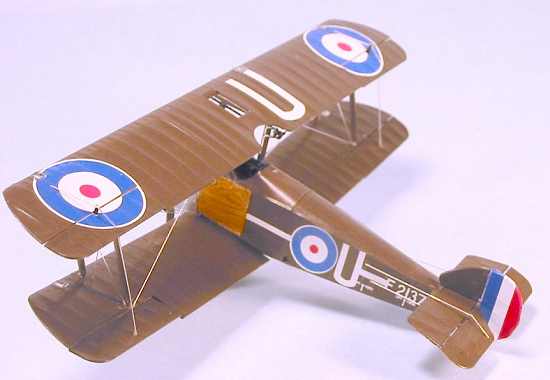 Following his graduation from flight training, MacLaren was assigned to 46
Squadron on the Western Front, flying the Sopwith Camel. His timing was
fortunate, since there was not a lot of action at this point. With Russia
now out of the war following the Bolshevik Revolution, the Germans were
conserving their forces as they planned for what they expected would by the
final offensive of the war in the coming Spring. Because of this, the
young 2nd Lieutenant had the luxury of learning about combat
flying from reconnaissance and ground strafing sorties before he finally
entered an aerial combat on March 6, 1918.
Following his graduation from flight training, MacLaren was assigned to 46
Squadron on the Western Front, flying the Sopwith Camel. His timing was
fortunate, since there was not a lot of action at this point. With Russia
now out of the war following the Bolshevik Revolution, the Germans were
conserving their forces as they planned for what they expected would by the
final offensive of the war in the coming Spring. Because of this, the
young 2nd Lieutenant had the luxury of learning about combat
flying from reconnaissance and ground strafing sorties before he finally
entered an aerial combat on March 6, 1918.
On patrol between Arras and Cambrai with four other Camels, MacLaren’s flight leader spotted three German s to the east. With the sun behind them, the Camels gained altitude without being spotted. MacLaren recognized the German aircraft as Hannover Cl.IIIs as he dove into the attack. Latching onto one that attempted to dive out of the fight, MacLaren followed the Hannover. Just as he lined up for his first shot, the German banked sharply. MacLaren followed, closing to 100 feet before opening fire. As he came around for a second pass, he found the Hannover spinning down out of control. He followed it till it crashed and exploded, to confirm the victory.
Within a matter of days, the great German offensive of 1918 opened on the Western Front. With reinforcement from the German units that had been on the Eastern Front, the Germans sent 100 divisions against 60 Allied divisions and came within an ace of breaking through the Allied front in desperate fighting through March and April. Aerial activity also increased, and MacLaren scored his second victory on March 10 when she shot the tail off an Albatros D.V.
The Germans had brought forward several enormous railway artillery guns to support their offensive; one was shelling the British rear from a railway junction at St. Pol. On March 21, MacLaren and six other pilots from 46 Squadron made a low-level attack on this weapon, each dropping four 20-pound Cooper Bombs. MacLaren scored two direct hits on the mountings and tracks, and the gun was put out of action.
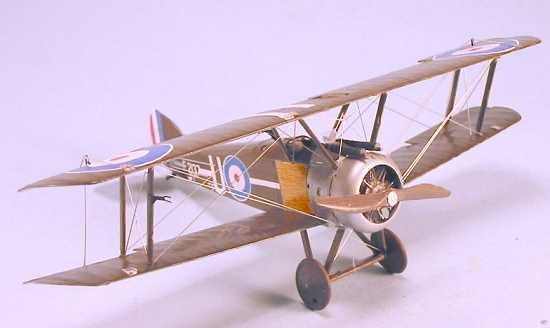 Separated from the others, he spotted an LVG C.VI, which he attacked and
shot down. While climbing away from this to avoid anti-aircraft fire, he
nearly collided with a German observation balloon, which he turned and
attacked. Setting it afire, he turned for home, when he spotted another
LVG just behind the German lines at Graincourt. This German put up a good
fight, scoring hits with both the nose gun and the observer’s machine gun,
which ripped the wings of MacLaren’s Camel. He dove on the LVG and shot it
out with the observer, killing him. The pilot nearly evaded further
attacks, but was now so low he had to straighten out to head for safety.
As he did so, MacLaren bored in again and shot the plane into the ground
where it exploded.
Separated from the others, he spotted an LVG C.VI, which he attacked and
shot down. While climbing away from this to avoid anti-aircraft fire, he
nearly collided with a German observation balloon, which he turned and
attacked. Setting it afire, he turned for home, when he spotted another
LVG just behind the German lines at Graincourt. This German put up a good
fight, scoring hits with both the nose gun and the observer’s machine gun,
which ripped the wings of MacLaren’s Camel. He dove on the LVG and shot it
out with the observer, killing him. The pilot nearly evaded further
attacks, but was now so low he had to straighten out to head for safety.
As he did so, MacLaren bored in again and shot the plane into the ground
where it exploded.
Now an ace, MacLaren received the Military Cross and promotion to 1st Lieutenant for this action.
From this point to the end of the war, combat was close to a daily experience. Jagdstaffel 1, led by Baron Manfred von Richtofen, had moved into the area where 46 Squadron operated, and the British pilots came up against numerous large German formations, which led to the British squadrons operating together. Soon air battles over the front could include over 100 airplanes in a single fight. By the end of March, MacLaren had shot down six more German aircraft, including a Junkers J.1 heavily armored ground attack plane.
On April 1, 1918, the Royal Flying Corps and Royal Naval Air Service became the Royal Air Force, and MacLaren received a promotion to Captain in recognition of his achievements in the previous month of combat, now that his score was 11 aircraft and two balloons.
A few days later, MacLaren’s career almost came to an abrupt end. Leading a flight, he attacked a gaggle of German fighters and shot down two. German “Archie” found his range and a shell smashed two of his Camel’s cabane struts and ripped off several bracing wires. A second close burst damaged his wing. With careful flying, MacLaren was able to return to his field at Baupaume and land. On inspection, the ground crews found the leading edge of the upper right wing had been separated - it was a miracle it hadn’t failed during the flight home.
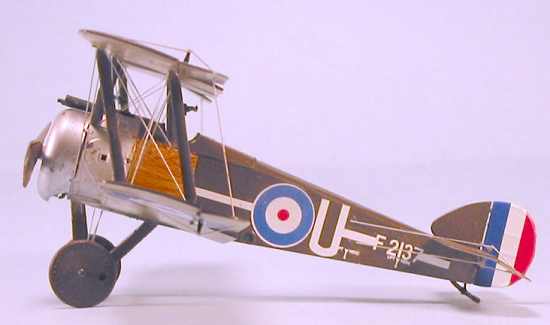 On April 7th, MacLaren spotted an enemy two-seater and dove on
it. When he pulled the trigger, the guns didn’t fire. Pulling off he
discovered that both belts of bullets were broken. In the meantime, the
German made no attempt to fire on him. When he approached, the observer
stood up in his cockpit and pointed at his weapon, indicating it was
jammed. With neither able to shoot the other, MacLaren waggled his wings
and went home.
On April 7th, MacLaren spotted an enemy two-seater and dove on
it. When he pulled the trigger, the guns didn’t fire. Pulling off he
discovered that both belts of bullets were broken. In the meantime, the
German made no attempt to fire on him. When he approached, the observer
stood up in his cockpit and pointed at his weapon, indicating it was
jammed. With neither able to shoot the other, MacLaren waggled his wings
and went home.
During heavy fighting through the month of May, MacLaren increased his score by 17, and two more balloons. During three fights, he scored multiple victories, clearly demonstrating he had “found his eye” as an aerial gunner. He then went through a “dry spot” for nearly the whole of the month of June, during which he only shot down two enemy aircraft, though his Squadron Leader commended him officially for his daring in leading attacks against the enemy even when outnumbered.
The month of June saw the superb Fokker D.VII - which had first appeared over the front the previous month - start showing up in larger numbers as Jagdgeschwader 1 was almost completely re-equipped with this outstanding fighter that outclassed anything the Allies had. For the rest of the war, MacLaren would be fighting enemies who had better equipment.
In July, MacLaren shot down eight airplanes - including two new D.VIIs in one fight - and two balloons, bringing him out of his slump and leading to a second award of the Military Cross.
The defensive battle waged by the Allies since the beginning of the German offensive ended with containment of the Germans in July. On August 8, 1918 the great Allied counteroffensive that would lead to final victory began at Amiens, with the Canadian Corps in the lead. The German Jastas fought with fury born of desperation and confidence in the D.VII as they strove to protect the German troops in the trenches below.
On the first day of the offensive, MacLaren was leading seven Camels on a patrol between Albert and Baupaume when he sighted a twenty German fighters in the misty morning. Leading the others into the clouds, he maneuvered into position to surprise four Fokkers. He dove on one and shot it down, when five more joined the two survivors out of the mist, and MacLaren’s Camel had its tail well-ventilated before he lost his pursuers in the clouds. He rejoined his flight just in time to be attacked by another 20 Fokkers. Recognizing a bad situation, the Camels dove for their lines and escaped.
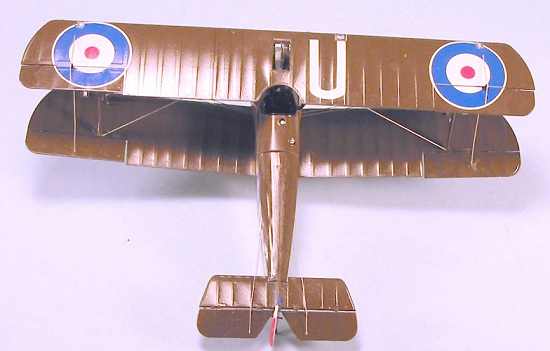 Bad weather intervened for the next two weeks, but late August saw the
weather improve and 46 Squadron went back to work as ground strafers,
interdicting supply and troop columns moving to the front. This was
dangerous work and several Camels were lost to ground fire. Despite the
main mission being that of ground attack, MacLaren still found opportunity
to score. Early on August 26 46 Squadron encountered a large formation of
Fokker D.VIIs around Peronne. The Germans were above and the British, but
had neglected to see the S.E.5a’s flying high escort to the Camels. As the
S.E.5s dove on the Germans, 46 Squadron turns and trapped the enemy between
the two British units. In the ensuing fight, five Fokkers went down,
including one by MacLaren. The victory was made all the better by the fact
that both British units returned without loss.
Bad weather intervened for the next two weeks, but late August saw the
weather improve and 46 Squadron went back to work as ground strafers,
interdicting supply and troop columns moving to the front. This was
dangerous work and several Camels were lost to ground fire. Despite the
main mission being that of ground attack, MacLaren still found opportunity
to score. Early on August 26 46 Squadron encountered a large formation of
Fokker D.VIIs around Peronne. The Germans were above and the British, but
had neglected to see the S.E.5a’s flying high escort to the Camels. As the
S.E.5s dove on the Germans, 46 Squadron turns and trapped the enemy between
the two British units. In the ensuing fight, five Fokkers went down,
including one by MacLaren. The victory was made all the better by the fact
that both British units returned without loss.
The last two full months of the First World War saw some of the most intense fighting of the entire war, as the Americans opened the Meuse-Argonne Offensive, and the British and French maintained their offensives against the Hindenburg Line.
On September 15, 1918, flying alone, MacLaren saw a British observation balloon in flames west of Havrincourt Wood. He dove and found six Fokkers around it. Pulling the trigger he found he only had one working gun, but continued his attack and shot down one D.VII out of control. The other five then attacked him and he had all he could do to escape. The next day he led two other Camels on a patrol behind German lines. Spotting four Fokkers, MacLaren led the attack and forced the Germans to dive to escape. During fight all four D.VIIs were destroyed, with two falling to MacLaren. The attack brought his score to 37, and he was awarded the DFC.
A few days later, 46 lost their Squadron Leader to a collision with a new pilot in the squadron during a dogfight.
MacLaren was given command of the squadron, nine months after having joined as a junior Lieutenant. On October 2, 1918, He led 15 Camels over the front in three flights of five, each at a different altitude. Over the German lines, eight D.VIIs attacked from out of the sun. MacLaren became in an intense dogfight with the leader, each exchanging bursts of machine gun fire. He used the Camel’s superb turning capability and got on the enemy’s tail, sending the Fokker down in flames. Just at this moment, 20 more D.VIIs dove into the fight. Attempting to get away, MacLaren turned into the pursuing enemy and shot down the leading aircraft just as the two high flights of Camels dove to the rescue.
A week later, MacLaren entered combat for what would prove to be the last time, when he shot down another LVG two-seater. The next day, while wrestling with a squadron mate, he managed to break his leg and was put out of action. MacLaren returned to England on November 6, 1918 and spent the Armistice in the Royal Flying Corps Hospital in London. His score of 48 aircraft and 6 balloons was only bettered by his countrymen, Raymond Collishaw and William Barker as regards Canadians fighting in the First World War.
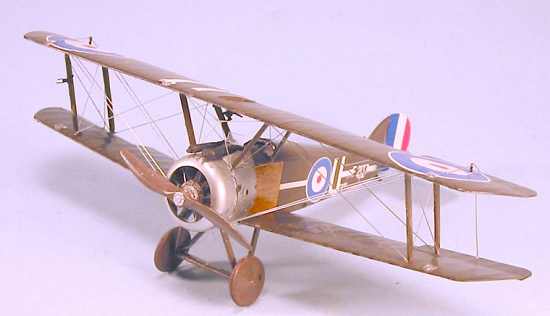 After the Armistice, MacLaren was awarded the DSO. His final score of 54
left him tied as sixth-ranking Allied ace with the South African Allan
Beauchamp-Proctor and Georges Guynemer. Overall, he is ranked 8th
behind Manfred von Richthofen, Rene Fonck, Edward Mannock, William Bishop,
Ernst Udet, Raymond Collishaw, and James McCudden. His victory score,
accomplished in seven and a half months of the heaviest fighting of the
war, during which he rose from junior Lieutenant to Major commanding the
squadron, is outstanding.
After the Armistice, MacLaren was awarded the DSO. His final score of 54
left him tied as sixth-ranking Allied ace with the South African Allan
Beauchamp-Proctor and Georges Guynemer. Overall, he is ranked 8th
behind Manfred von Richthofen, Rene Fonck, Edward Mannock, William Bishop,
Ernst Udet, Raymond Collishaw, and James McCudden. His victory score,
accomplished in seven and a half months of the heaviest fighting of the
war, during which he rose from junior Lieutenant to Major commanding the
squadron, is outstanding.
After the war, MacLaren remained in the service and participated in the creation of the Royal Canadian Air Force, becoming commander of Fighter Squadron 1 in 1920. Resigning his commission in 1921, he returned to Vancouver and started Pacific Airways Ltd., with one Curtiss HS-2L flying boat. In 1926, he led the effort to reorganize the RCAF and take it out of further civil aviation development through the Aeronautics Act of 1927 and to organize private flying clubs throughout the country to provide trained pilots in the event of emergency. He merged his company with Western Canada Airways in 1928 and expanded operations into the Yukon and Arctic. In 1929, he and H. Hollick-Kenyon flew the first airmail service for WCA between Regina, Moose Jaw, Medicine Hat, Lethbridge and Calgary.
MacLaren eventually became a senior executive in Trans-Canada Airlines and retired from that company in 1958. Having participated in the development of Canadian aviation from its earliest days, Donald MacLaren died in his sleep on July 4, 1989, at age 96.
| THE KIT |
Eduard’s Camel has already attained accolades for being the best kit of this famous fighter to be released to date in any scale. This non-Profipack version provides photo-etch seatbelts. Four different Camels are included on the decal sheet, including Donald MacLaren’s F2137, which he flew through the last months of the war. For a look at what comes in the box, please visit the preview.
| CONSTRUCTION |
With its excellent production design, the Eduard Camel is a good WW1 project for a modeler with a couple of more simple projects under their belt, inasmuch as the Camel is “fully rigged.” That said, the rigging is probably the most difficult part of this project, making it a good “mid-level” project in terms of overall difficulty.
 The kit has lots of detail in the cockpit. Unfortunately, in the standard
Camel this is all hard to see in the final product, given the position of
the wing directly over the cockpit, even though it has a fairly-large
opening. In fact, the only thing one can see very well at all is the seat
and seatbelts. The kit provides decals for the plastic seat to give a
“wicker” effect. As to painting the rest of the detail inside the cockpit,
the truth is you can only barely see the guns, instrument panel and seat,
but I gave it a basic painting following the instruction sheet color
call-outs nonetheless, and used some wood decal on the inside of the
fuselage for looks. As it turned out, you can barely see any of this in
the final product.
The kit has lots of detail in the cockpit. Unfortunately, in the standard
Camel this is all hard to see in the final product, given the position of
the wing directly over the cockpit, even though it has a fairly-large
opening. In fact, the only thing one can see very well at all is the seat
and seatbelts. The kit provides decals for the plastic seat to give a
“wicker” effect. As to painting the rest of the detail inside the cockpit,
the truth is you can only barely see the guns, instrument panel and seat,
but I gave it a basic painting following the instruction sheet color
call-outs nonetheless, and used some wood decal on the inside of the
fuselage for looks. As it turned out, you can barely see any of this in
the final product.
The separate control surfaces are very nice, and very delicate. I have become convinced that one should not attach the tail surfaces until after everything has been painted and decaled, since any handling at all is likely to knock off an elevator, and the fix will end up being just clumsy enough to be noticeable close up. I think one could also avoid attaching the ailerons until the final assembly stage after painting and decaling is completed.
Once the fuselage, lower wing and tail surfaces were attached, it was time for painting.
| COLORS & MARKINGS |
Painting:
 I first painted the forward fuselage area with SNJ Aluminum. When that was
dry, I masked it off and pre-shaded the rest of the model, airbrushing flat
black on all the ribs and other structure. I then painted the lower
surfaces with Gunze-Sangyo “Sail Color.” I
I first painted the forward fuselage area with SNJ Aluminum. When that was
dry, I masked it off and pre-shaded the rest of the model, airbrushing flat
black on all the ribs and other structure. I then painted the lower
surfaces with Gunze-Sangyo “Sail Color.” I
 masked that off and shot the
upper surface with P.C.10 - this is a color that can range from chocolate
brown to Olive Green, depending on the paint batch and manufacturer. There
is no way of telling from a black and white photo which shade of P.C.10 an
airplane is in. I have my own mixture, started with some Tamiya Khaki,
into which I mix various amounts of Olive Drab, Green, and Red-Brown
whenever I do a British World War I airplane. This insures that no two of
them are exactly the same color - when you have several British airplanes
in your World War I collection, the many bright colors (not!) can quickly
get boring otherwise. When all was dry, I gave the model a coat of Future.
masked that off and shot the
upper surface with P.C.10 - this is a color that can range from chocolate
brown to Olive Green, depending on the paint batch and manufacturer. There
is no way of telling from a black and white photo which shade of P.C.10 an
airplane is in. I have my own mixture, started with some Tamiya Khaki,
into which I mix various amounts of Olive Drab, Green, and Red-Brown
whenever I do a British World War I airplane. This insures that no two of
them are exactly the same color - when you have several British airplanes
in your World War I collection, the many bright colors (not!) can quickly
get boring otherwise. When all was dry, I gave the model a coat of Future.
Decals:
I first used some wood decal to do the side panels of the fuselage, and when they were dry hand-painted them with Gunze “Clear Yellow” to make them look varnished. I used the kit decals for the rest, and these went down with no problems under Micro-Sol. When they were dry, I washed the model to get rid of decal solvent residue and gave the model another coat of Future.
| FINAL CONSTRUCTION |
I attached the engine and its cowling, then attached the landing gear. I glued the cabane and interplane struts in place with cyanoacrylate glue, then attached the top wing.
Rigging was accomplished with .008 steel wire, using the kit rigging diagram.
| CONCLUSIONS |
The Camel is one of my all time favorite World War I airplanes, and this now gives me three of the new Eduard kits in the collection. The kit is the World War I equivalent of a Tamiya kit, and while not exactly a “slammer” compared with something like a Spitfire, it is not nearly so difficult as many might believe. The only hard part is rigging, and the secret there - as with almost everything else associated with plastic model airplane building - is to take your time. If someone ever comes out with decals to do Collie’s Camel, I am sure there could be another of these great kits turn up in the stash.
September 2004
Review Kit courtesy Eduard
If you would like your product reviewed fairly and fairly quickly, please contact the editor or see other details in the Note to Contributors.